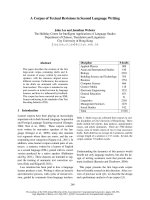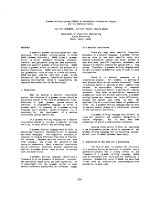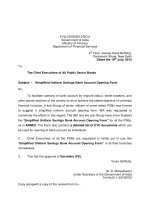09 Physical and Chemical Characteristics of DDGS revisions.
Bạn đang xem bản rút gọn của tài liệu. Xem và tải ngay bản đầy đủ của tài liệu tại đây (319.08 KB, 8 trang )
User Handbook
Physical & Chemical
Characteristics of DDGS
Physical & Chemical
Characteristics of DDGS
08 - Physical & Chemical Characteristics of DDGS
1
Physical & Chemical Characteristics
of U.S. DDGS
Physical and chemical characteristics of distiller’s dried grains with solubles (DDGS) vary
among sources and can influence its feeding value and handling characteristics. These
characteristics include color, smell, particle size, bulk density, pH, flowability, shelf life stability
and hygroscopicity.
Color
Color of DDGS can vary from being very light yellow in color to being very dark brown in
color. Differences in color among DDGS sources are influenced by;
• the natural color of the feedstock grain being used,
• the amount of solubles added to grains before drying,
• drying time, and drying temperature.
The color of corn kernels can vary among varieties and has some influence on final DDGS
color. Corn-sorghum blends of DDGS are also somewhat darker in color than corn DDGS
because of the bronze color of many sorghum varieties.
When a relatively high proportion of solubles are added to the mash (grains fraction) to make
DDGS, the color becomes darker. Noll et al. (2006) conducted a study where they evaluated
color in batches of DDGS where approximately 0, 30, 60 and 100% of the maximum possible of
syrup was added to the mash before drying. Actual rates of solubles addition to the mash were 0,
12, 25 and 42 gallons/minute. As shown in Table 1, increasing solubles addition rate to the mash
resulted in a decrease in L* (lightness of color) and b* (yellowness of color), with an increase in
a* (redness of color). Similar results were also reported by Ganesan et al. (2005).
Table 1. The Effect of the Rate of Solubles
Addition to Mash on Color Characteristics of DDGS
0
gal/min
12
gal/min
25
gal/min
42
gal/min
Pearson
Correlation
P
Value
Color (CIE Scale)
L*
59.4 56.8 52.5 46.1 - 0.98 0.0001
a*
8.0 8.4 9.3 8.8 0.62 0.03
b*
43.3 42.1 40.4 35.6 - 0.92 0.0001
Adapted from Noll et al. (2006).
Dryer temperatures in dry-grind ethanol plants can range from 127 to 621º C. The amount of
time DDGS spends in the dryer also influences the color. In general, the higher the dryer
temperature and the longer DDGS remains in the dryer, the darker the resulting DDGS will be.
Smell
High quality DDGS has a sweet, fermented smell. DDGS that has a burned or smoky smell has
been overheated.
08 - Physical & Chemical Characteristics of DDGS
2
Particle Size, Bulk Density and pH
Particle size and particle size uniformity of feed ingredients are important considerations of
livestock and poultry nutritionists when selecting sources and determining the need for further
processing when manufacturing complete feeds or feed supplements. Particle size affects:
1. Nutrient digestibility – as particle size is reduced, nutrient digestibility and feed
conversion is improved. This is due to the increasing amount of surface area of an
ingredient that is exposed and available for digestive enzymes to act upon.
2. Mixing efficiency – a more uniform particle size in a mixture of ingredients will reduce
mixing time in order to achieve a uniformly distributed mix of ingredients in a complete
feed.
3. Amount of ingredient segregation during transport and handling – particle and ingredient
segregation (separation) occurs when particles of different sizes and bulk densities are
blended together and transported or handled.
4. Pellet quality – is often defined as the hardness of the pellet and percentage of fines in the
complete feed after pelleting. For corn-soybean meal based diets, a low mean particle
size (400 microns) generally results in a higher quality pellet (less % fines).
5. Bulk density – is a measure describing the weight of an ingredient per unit volume. In
general, bulk density can be increased by reducing particle size to increase the weight of
a feed ingredient or complete feed per unit of volume.
6. Palatability and sorting of meal or mash diets – depending on the animal, a finely ground,
powdery feed will reduce feed intake and cause bridging in feeders and storage bins.
Extremely coarsely ground feeds can also reduce palatability.
7. Incidence of gastric ulcers – in swine, the incidence of gastric ulcers increases as the
mean particle size of the diet is reduced.
Bulk density is an important factor to consider when determining the storage volume of
transport vehicles, vessels, containers, totes and bags. Bulk density affects transport and storage
costs. Low bulk density ingredients have higher cost per unit of weight. It also affects the amount
of ingredient segregation that may occur during handling of complete feeds. High bulk density
particles settle to the bottom of a load during transport, whereas low bulk density particles rise to
the top of a load.
Several unpublished studies have been conducted at the University of Minnesota to compare
particle size and bulk density among DDGS sources. The first study was conducted during the
summer of 2001 where representative samples of DDGS (4.5 kg) were obtained from 16 ethanol
plants in Minnesota, South Dakota and Missouri. From these samples, a 200 gram subsample of
DDGS from each plant was screened through five U.S. sieves and the weight of the DDGS not
filtering through each screen was determined and recorded. The fine particles that filtered
through all screens were collected in the pan and weighed. The U.S. sieve numbers and their
corresponding size of screen openings (microns) were #10, #16, #18, #20 and #30 representing
2000, 1180, 1000, 850 and 600, respectively. The size of DDGS particles collected in the pan
was less than 600 microns. The weights of DDGS collected on each screen were then used to
calculate the percentage of weight of each fraction of the total separated. In addition to
determining the average particle size (geometric mean), the coefficient of variation (CV) and
08 - Physical & Chemical Characteristics of DDGS
3
standard deviation (SD) of particle size within and among ethanol plants were calculated. These
results are shown in Table 3.
Bulk density (lbs/cubic foot) was determined by filling a one quart container and weighing the
amount of DDGS to fill the container (results shown in Table 3). Samples were also visually
evaluated for color and the presence of “syrup balls.”
The average particle size among the 16 ethanol plants was 1,282 microns (SD = 305, CV=
24%), and ranged from 612 microns in plant 6 to 2,125 microns in plant 15. Thus, there is
considerable variation in average particle size of DDGS originating from these modern ethanol
plants. As a point of reference, the target mean particle size for meal or mash diets for swine and
poultry is 600-800 microns. Only plants 6 and 7 were close to this target range. All other plants
produced coarser DDGS particles suggesting that further grinding of DDGS may be warranted to
reduce the mean particle size, improve particle size uniformity and optimize nutrient digestibility
of DDGS in a complete mixed feed. Plant 15 had the highest mean particle size (2125 microns).
Ethanol plants that produced DDGS with high amounts of syrup balls tended to have a higher
mean particle size.
Bulk density averaged 35.7 lbs/cubic foot (SD = 2.79, CV = 7.8%), but ranged from 30.8 to
39.3 lbs/cubic foot. However, the correlation between mean particle size and bulk density was
surprisingly very low (r = 0.05) which may be due to the variable amounts of syrup balls among
the samples collected.
Table 3: Mean and Variation of Particle Size
Among Ethanol Plants and Bulk Density of DDGS in 2001
Plant Particle Size Mean Standard Deviation Bulk Density CV %
68% of the particles
will fall between:
1
1398 2.32 36.3 0.17 603 3243
2
1322 2.00 39.2 0.15 661 2644
3
1425 1.62 36.8 0.11 880 2309
4
1370 1.84 36.3 0.13 745 2521
5
1255 1.68 33.5 0.13 747 2108
6
612 2.75 39.3 0.45 223 1683
7
974 2.15 36.1 0.22 453 2094
8a
1258 1.70 33.7 0.14 740 2139
8b
1142 1.84 30.8 0.16 621 2101
9
1337 1.78 31.8 0.13 751 2380
10
1488 1.62 38.2 0.11 919 2411
12
1235 1.75 31.4 0.14 706 2161
13
1198 1.87 35.9 0.16 641 2240
14
1229 2.09 39.2 0.17 588 2569
15
2125 1.56 37.6 0.07 1362 3315
16
1148 2.25 35.1 0.20 510 2583
Average 1282.25 1.93 35.7 0.15 697 2406
Two additional DDGS nutrient analysis and physical characteristics surveys were conducted by
researchers at the University of Minnesota in 2004 (34 samples from ethanol plants in 11
different states) and 2005 (35 samples). As shown in Tables 4 and 5, average particle ranges
08 - Physical & Chemical Characteristics of DDGS
4
were 665-737 µm, but the range in particle size is extremely large 73 to 1217 µm. The pH of
DDGS sources averages 4.1 but can range from 3.6-5.0.
Table 4: Particle Size, Bulk Density, and pH of 34 DDGS Sources Analyzed in 2004.
Average Range SD CV, %
Particle size, µm
665 256 - 1087 257.48 38.7
Bulk density, lbs/ft
3
31.2 24.9 – 35.0 2.43 7.78
pH
4.14 3.7 – 4.6 0.28 6.81
Table 5: Particle Size, Bulk Density, and pH of 35 DDGS sources analyzed in 2005.
Average Range SD CV, %
Particle size, µm
737 73 – 1217 283 38.0
Bulk density, lbs/ft
3
25.2 22.8 – 31.5 8.6 34.2
pH
4.13 3.6 – 5.0 0.33 7.91
Flowability
Flowability is defined as the ability of granular solids and powders to flow during discharge
from transportation or storage containments. Flowability is not an inherent natural material
property, but rather a consequence of several interacting properties that simultaneously influence
material flow (Rosentrater, 2006). Flowability may be affected by a number of synergistically
interacting factors including product moisture, particle size distribution, storage temperature,
relative humidity, time, compaction pressure distribution within the product mass, vibrations
during transport and/or variations in the levels of these factors throughout the storage process
(Rosentrater, 2006).Other factors that may affect flowability include chemical constituents,
protein, fat, starch and carbohydrate levels as well as the addition of flow agents.
Under certain conditions, DDGS can exhibit poor flowability (AURI and MN Corn Growers
Assoc., 2005). (National Corn-to-Ethanol Research Center, 2005). “Clumping” or “caking” can
occur as a result of loading DDGS into trucks, rail cars or containers if it has not been cooled and
“cured” properly before loading. This often causes flowability problems and difficulty unloading
DDGS. Reduced flowability and bridging of DDGS in bulk storage containers and transport
vehicles has limited the acceptability of some DDGS sources for some customers and rail car
owners.
Research studies are being conducted to determine the factors that cause flowability problems
and potential solutions to reduce these problems.. The Agricultural Utilization Research Institute
and the Minnesota Corn Growers Association (2005) studied a limited number of DDGS samples
under laboratory conditions. They reported that relative humidity greater than 60% seemed to
reduce flowability of a DDGS sample, which is likely due to the product’s ability to absorb
moisture. While moisture from both the environment and the DDGS itself likely influence
flowability, many other factors have been suggested as possible controllers of flowability such as
particle size, content of solubles, dryer temperature, moisture content at dryer exit, and others.
Interventions to improve flowability of DDGS have been limited to trial and error approaches
within ethanol plants. Some of these interventions involve regulating the completeness of
fermentation, adjusting moisture content and changing particle size. However, results from these
studies have not been published in the scientific literature. Iowa Limestone Company Resources
(2003) investigated the effectiveness of including 2% calcium carbonate in DDGS as a









